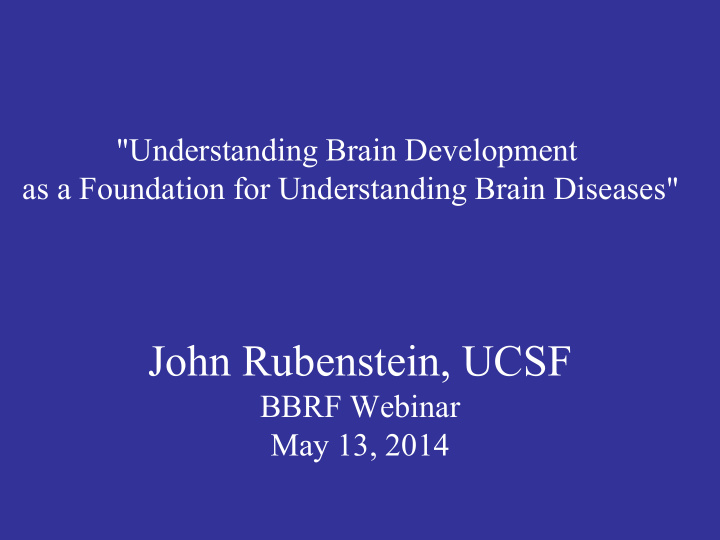



"Understanding Brain Development as a Foundation for Understanding Brain Diseases" John Rubenstein, UCSF BBRF Webinar May 13, 2014
Hypothesis: Many Psychiatric Disorders Are Caused by Dysfunction of Brain Circuits Due to Abnormal Development and/or Function of Specific Circuits
Two General Types of Circuits
Long Distance Circuits From : Charles Gerfen
Local Circuits From : Oscar Marin
Review of Major Steps in Brain Development
Steps In Neural Development Induction Neurulation Regional Patterning (anteroposterior, dorsoventral) Proliferation Migration (mediolateral patterning of the neural tube) Axon Pathfinding and Synapse Formation Myelination
Steps In Neural Development Induction* Neurulation* Regional Patterning (anteroposterior, dorsoventral) Proliferation Migration (mediolateral patterning of the neural tube) Axon Pathfinding and Synapse Formation Myelination
Neurulation and Early Patterning Centers
Patterning Centers in the Forebrain
Steps In Neural Development Induction Neurulation Regional Patterning (anteroposterior, dorsoventral)* Proliferation Migration (mediolateral patterning of the neural tube) Axon Pathfinding and Synapse Formation Myelination
Blueprint of the Brain
Transverse and Longitudinal Organization of the CNS Neural Plate Neural Tube
Monoamine Neurons: Specific Locations Acetylcholine Histamine Norepinephrine Serotonin
Steps In Neural Development Induction Neurulation Regional Patterning (anteroposterior, dorsoventral) Proliferation* Migration (mediolateral patterning of the neural tube) Axon Pathfinding and Synapse Formation Myelination
Progenitor Zones
Steps In Neural Development Induction Neurulation Proliferation Regional Patterning (dorsoventral)* Migration (mediolateral patterning of the neural tube) Axon Pathfinding and Synapse Formation Myelination
Patterning Centers in the Forebrain
“Dorsoventral” Subdivisions Of the Telencephalon Transcription Factors Which Regulate Regional Patterning And Differentiation of the Telencephalon
Patterning of Regions and Neural Identity Marín O, Rubenstein JL. Nat Rev Neurosci. 2001 Nov;2(11):780-90
Steps In Neural Development Induction Neurulation Regional Patterning (anteroposterior, dorsoventral) Proliferation Migration (mediolateral patterning of the neural tube)* Axon Pathfinding and Synapse Formation Myelination
Radial Migration in the Telencephalon Radial Migration of Projection Neurons
Radial Migration to Build the Cortex From: Lui JH, Hansen DV, Kriegstein AR. Cell. 2011 Jul 8;146(1):18-36
Tangential Migration of Interneurons Marín O, Rubenstein JL. Nat Rev Neurosci. 2001 Nov;2(11):780-90
Radial and Tangential Migration in the Telencephalon Radial Migration of Tangential Migration of Projection Neurons Local Circuit Neurons
Assembly of Circuits
Cortical Circuits: Projection Neurons and Interneurons Marín O. Nat Rev Neurosci. 2012 Jan 18;13(2):107-20.
Steps In Neural Development Induction Neurulation Regional Patterning (anteroposterior, dorsoventral) Proliferation Migration (mediolateral patterning of the neural tube) Axon Pathfinding and Synapse Formation* Myelination
Axons Grow Transversely or Longitudinally Follow Specific Molecular Landmarks Transverse Pathways
Longitudinal Pathways: Branch at Functionally Related Nuclei
Corpus Callosum Autism Traits in Individuals with Agenesis of the Corpus Callosum Lau YC, Hinkley LB, Bukshpun P, Strominger ZA, Wakahiro ML, Baron-Cohen S, Allison C, Auyeung B, Jeremy RJ, Nagarajan SS, Sherr EH, Marco EJ. J Autism Dev Disord. 2012 Oct 5.
Steps In Neural Development Induction Neurulation Regional Patterning (anteroposterior, dorsoventral) Proliferation Migration (mediolateral patterning of the neural tube) Synapse Formation and Function* Myelination
Molecular Defects at the Synapse in Autism Walsh, Morrow and Rubenstein, 2008
Steps In Neural Development Induction Neurulation Regional Patterning (anteroposterior, dorsoventral) Proliferation Migration (mediolateral patterning of the neural tube) Synapse Formation and Function Myelination, and Functions of Non-neural cells*
Models For Mechanisms of Neurodevelopmental Disorders 1. Detection of salient synaptic information – signal/ noise processing (excitation/inhibition balance)
Epilepsy and Cognitive Dysfunction in Autism
“Tuning” Curve for Optimal Neural Circuit Function Optimal Function High Excitation Low Excitation Low Inhibition High Inhibition High Noise Low Noise but
Changes in the Numbers and Functions of GABA Interneurons Can Alter the Tuning Curve
Autistic-like behavior in . Scn1a +/- mice. Han et al. (Bill Catterall Lab) Nature. 2012 Sep 20;489(7416):385-90
Scn1a: Sodium Channel. . Model of Dravet Syndrome (Epilepsy, Cognitive Dysfunction with Autistic Behaviors).
Autistic-like behavior in Scn1a +/- mice was rescue by enhanced GABA-mediated neurotransmission (clonazepam treatment).
Projection and Local Circuit Neuron Defects in the Prefrontal Cortex in Schizophrenia From the work of the Lewis, Jones, Benes labs. Reviewed in Frankle et al., 2003
Models For Mechanisms of Neurodevelopmental Disorders 2. Cerebral hyperplasia secondary to increased growth factor signaling.
Transient Cortex Overgrowth in Some Autistic Individuals Work of several labs, including: E. Courchense J. Piven
Growth Factor Expression in the Forebrain
Models For Mechanisms of Neurodevelopmental Disorders 3. Dysfunction of cortical-basal ganglia circuits
Cortex-Basal Ganglia-Thalamus Circuit Descending Pathways From : Charles Gerfen
Prefrontal Cortex-Basal Ganglia-Thalamus Circuit Ascending Pathways Adapted from Charles Gerfen
Shank3 mutant mice display autistic-like behaviors and striatal dysfunction Peça J, Feliciano C, Ting JT, Wang W, Wells MF, Venkatraman TN, Lascola CD, Fu Z, Feng G. Nature. 2011 Apr 28;472(7344):437-42.
Shank3 mRNA is highly expressed in the striatum. Shank3 Regulates Assembly of Glutamate Receptor Complexes
Glutamate receptor protein subunits GluR2, NR2A and NR2B are reduced in striatal synapses of Shank3 −/− mice.
Schizophrenia Defects in the Prefrontal Cortex- Basal Ganglia-Thalamus Circuit
Prefrontal Cortex • Prefrontal Hypofunction and Hypoplasia • Interneuron Defects: Reduced GAD expression • Projection Neuron Defects: Reduced GABA-Receptor Expression
Basal Ganglia • Striatal (Caudate) Hypoplasia Thalamic Defects • Mediodorsal Nucleus Hypoplasia
Models For Mechanisms of Neurodevelopmental Disorders 4. The male brain/genotype Y Chromosome Sex steroids
Perhaps the female brain is protected from the genetic and environmental influences that lead to the 4:1 male:female ratio in autism and other childhood disorders.
In evaluating etiologies and therapies consider the steps and mechanisms in neurodevelopment Induction Neurulation Regional Patterning (anteroposterior, dorsoventral) Proliferation Migration (mediolateral patterning of the neural tube) Synapse Formation and Function Myelination, and Functions of Non-neural cells
And always consider the effects of those defects on the development and function of circuits From : Charles Gerfen
Recommend
More recommend